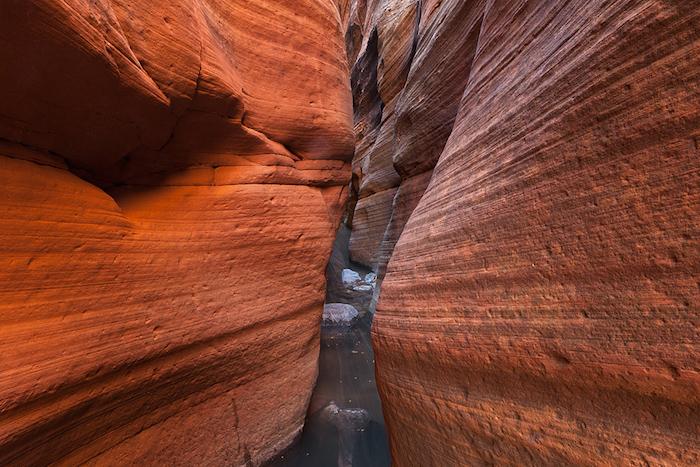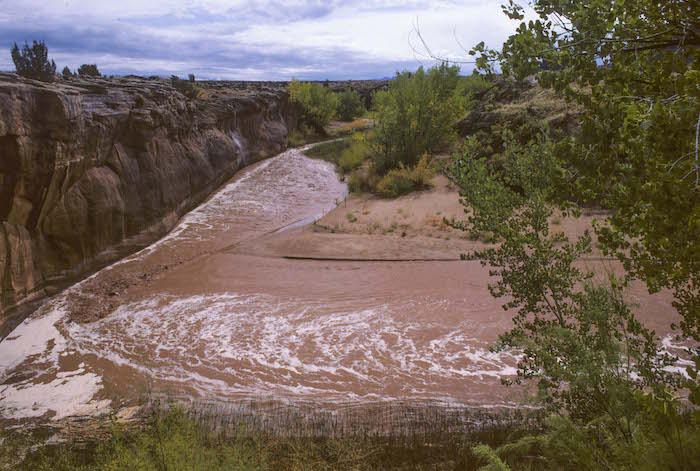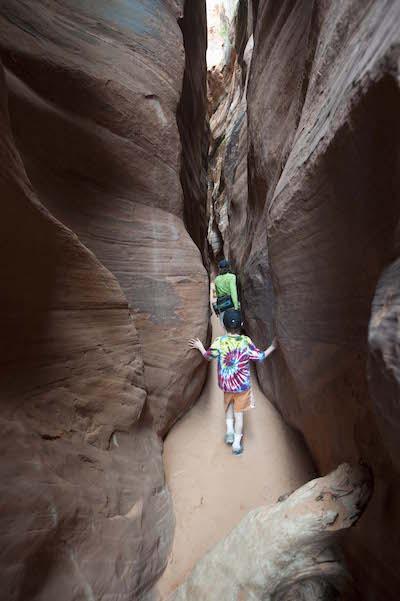
Beautiful and alluring, slot canyons can quickly turn deadly as this one, Keyhole Canyon in Zion National Park, did last week/Bret Edge
As wondrous and mesmerizing as slot canyons in southern Utah and northern Arizona can be, they can be even more deadly, as last week's tragedy at Zion National Park underscores.
The twisting, serpentine sandstone canyons have been carved into the landscape by countless flood waters down through the centuries. Wandering through them is one of the joys of exploring the region. Some require a series of rope rappels as you descend deeper and deeper into the canyons while moving downstream. Others feature pools of water in varying depths that can be both refreshing and bracing, as they seldom are warmed by the rays of the Sun.
Depending on the type of rock they are worn into -- sandstones or limestones -- the slots are distinctively colored in buffs, caramels, blacks, rouges, grays and blues. The national parks in Utah are well-known by canyoneers for the adventures they hold.
Zion holds arguably the most enticing slot -- the Narrows, a 16-mile-long route with walls rising 1,000 feet. It starts north of the park and ends in Zion Canyon, where the Virgin River exits the slots and flows down and out of the park. Elsewhere in and around the park there are more than a dozen other slots: the "Subway," Kolob Creek, Hidden Canyon, and Keyhole Canyon, where last week's drowning of seven canyoneers occurred, are just a handful.
Capitol Reef National Park northeast of Zion also has some notable slots -- Cottonwood Wash, Burro Wash, and Sulphur Creek -- as do Arches and Canyonlands national parks.

Flash floods don't just turn slot canyons deadly. Their walls of water, such as these in Courthouse Wash in Arches National Park, pose a serious threat to anyone in the stream/Patrick Cone
But the tight, sinuous nature of slot canyons make them extremely deadly when thunderstorms send torrents of rain either directly down on the slots or miles upstream, as the National Park Service staff at Zion notes on its website:
The Narrows are susceptible to flash flooding because much of the surrounding area is bare rock that does not absorb water. During storms, runoff is funneled rapidly into the Narrows. During a flash flood the water level rises almost instantly--within seconds or minutes. Flash floods are common in Zion and hikers have been stranded, injured, and even killed by venturing into narrow, flood prone canyons.
These torrents not only rage as suprising speed, but push tons of trees, rocks, and any other debris caught up in the waters. And when they flow through slot canyons, where walls can be spaced as little as 3 feet apart, this flow of water, mud and debris can quickly rise to 12 feet high, according to the National Park Service.
Even without flash floods, canyoneering is a dangerous sport due to the needed rappels, awkward footing at times, and heights. Despite the dangers, the slot canyons continue to draw the adventurous. And, over the years, they've been the scene of deaths. Here's a look at just some of the incidents, with details where available:
September 5, 1965: Authorities didn't know that anyone, let alone the Scotowa Expedition, a group dedicated to exploring remote tracts of the Southwest, was even in the canyon. Twenty-six people had walked into the world-class wonder, but only 21 walked out. Because of the gorge's narrowness and despite being alerted to both the storm and the hikers, rangers were helpless to even enter the flood-swollen trap.
One survivor said he "heard a sound like thunder and looked up and couldn't see any clouds. (We) turned around and a wall of driftwood, rocks and mud was bearing down on us." Another recalled, I have been through hurricanes in Florida, but they were nothing compared to this. There were hailstones as big as half an inch, and the flood, when it came, seemed to be a great white curtain of water. The rains blotted out everything around us."
The first dead child was found three hours before any of the surviving 21 hikers swam free of the canyon. Two more were soon discovered nearby; coming to rest in Springdale, the little bodies had been dragged 10 miles by the rampaging river.
By 5 p.m., after spending up to 27 hours trapped, the last of the fortunate survivors had waded out through the rushing chest-deep waters. Two teenage boys were never found. -- From Death, Daring, & Disaster, Search and Rescue in the National Parks by Charles R. "Butch" Farabee, Jr.
Postscript: In 2012 a skull fragment found in the Virgin River in 2006 was linked to one of the missing teenagers.
July 15, 1993: Nearly paralyzed, he watched his father swirl face down in the frigid pool only feet away. The horrified 14-year-old struggled against the powerful current of the narrow creek. Scant yards into the Mormon Church-sponsored quest, 37-year-old Kim had vaulted into the icy waters to free David: the trip's leader had a dangerously snagged backpack strap. But something went horribly wrong as two of the group's three adults whipped around in the foaming, bed-sized whirlpool. Kim died, not David. Tragically, in less than two hours, 27-year-old David would also suffer a savage death in the shadows of the rocky abyss. -- From Death, Daring, & Disaster, Search and Rescue in the National Parks by Charles R. "Butch" Farabee, Jr.
July 1998: Zion Narrows flash flood -2 Fatalities
May 13, 2001: Drowning caught in a cloud burst at Canyon Overlook Trail - 1 fatality
April 26, 2010: The bodies of two men who possibly had intended to build a log raft to float the Virgin River through "The Narrows" of Zion National Park were recovered Monday.
Sept. 18, 2012: A visitor to Zion National Park who was canyoneering in the popular "Subway" section died when his foot became trapped on a descent, according to a park release.

Slot canyons, such as Oak Creek Canyon in Capitol Reef National Park in Utah, are intriguing and beautiful, but they can be quite dangerous/Patrick Cone.
September 27, 2014: One of the most iconic hikes in the National Park System, one that also potentially is one of the deadliest, has claimed another victim. Heavy rains that have been pounding southern Utah for days swelled the Virgin River that flows through the Narrows at Zion National Park well above flood stage and claimed the life of a 34-year-old man.
Douglas Yoshi Vo, 34, of Westminster, California, and a companion had entered the Narrows from the Riverside Walk Trail early Saturday morning. At that time, the river was running at approximately 46 cubic feet per second, according to park officials. At roughly 9:30 a.m., however, rain began to fall and the pair decided to end their hike and go back down the Narrows to the Riverside Walk Trail.
"During their walk out, the river started rising rapidly and quickly reached flash flood levels, peaking at 4,020 CFS," park officials said. "The two hikers became stranded on high ground, but on opposite sides of the river. They could not communicate due to the noise from the river. They waited from around 10 a.m. until 4 p.m. for the water to recede, but it was still too high for them to hike out."
July 11, 2015: Negotiating Zion National Park's sandstone canyons via rope, with one rappel followed by another, is an exhilarating experience, but it also can be quite dangerous, as the death of a Las Vegas man demonstrates. Word wasn't received by park officials for about four-and-a-half hours, however, as the route is a strenuous, challenging technical one which involves about 3,000 feet in descent, they noted. It usually takes 12 to 20 hours to complete, consists of a number of rappels into cold water, and ends with a final 280-foot rappel to the Upper Emerald Pool area, the officials said.
September 14, 2015: Search and rescue crews at Zion National Park on Thursday recovered the seventh and final body from a group of canyoneers who entered a tight slot canyon on Monday for what they thought would be a relatively short, but enjoyable, journey through one of the park's serpentine wonderlands only to be overcome by raging waters of a flash flood.



Comments
The video is spectacular. But we need to note that its location WAS NOT IN THE NARROWS. This was actually right at the end of the paved Gateway to the Narrows Trail. The Narrows themselves are about a mile upstream.
I hope they gave the park service a copy and that it will be used in some way to try to educate visitors.
was there several years ago and it is an eerie feeling...the high walls and unsure footing of rocks and river stones ...the Rangers all over the Park Service DO tell people of the rules and dangers...it has always amazed me how people think it will never happen to them. This area is not safe...it can be warm and sunny and in seconds you can be swept up and banged against the walls. I don't need adrenal rush enough to go int there again